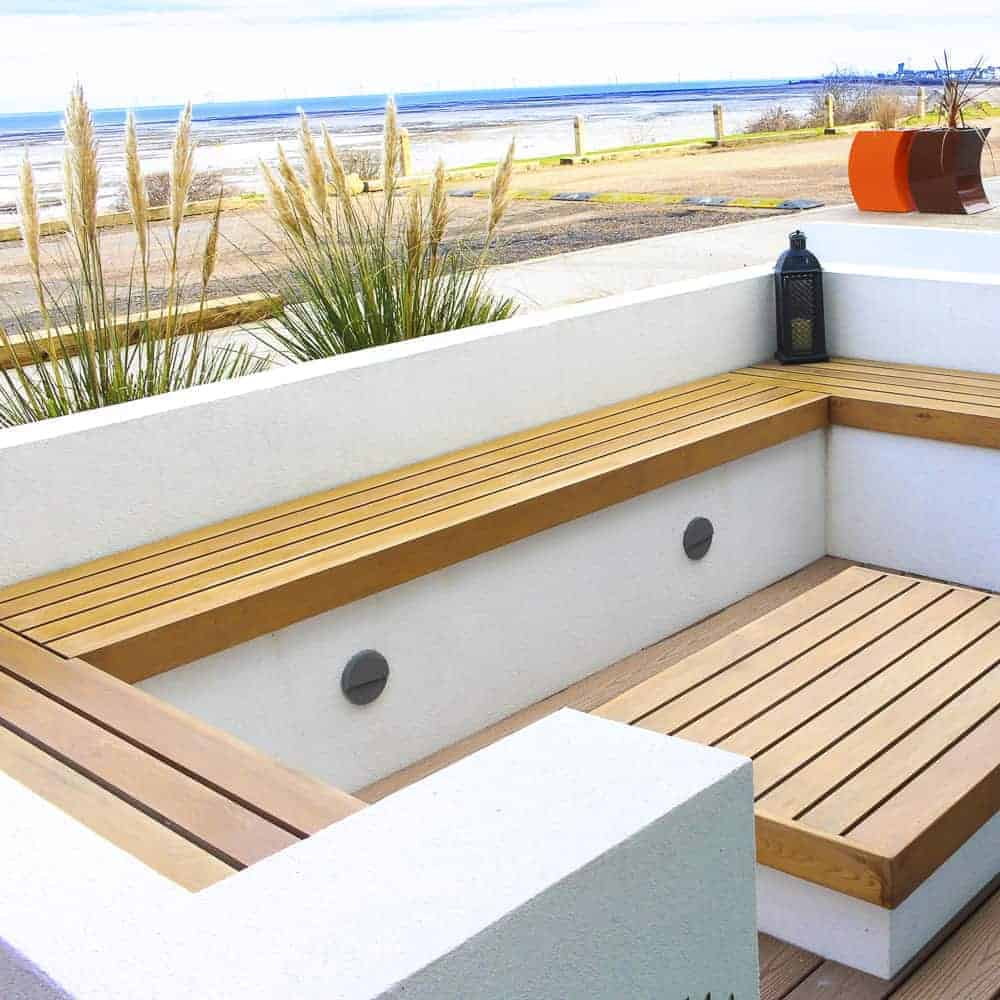So you want some garden seating area ideas? and want to find out the pros and cons of the different types of seating available, you have come to the right place.
Fixed garden seating areas are becoming increasingly popular. Many garden designers include garden seating areas in their designs, if you are considering having one built this guide will help you understand the pros and cons.
Cantilevered / floating garden benches
Floating benches are a very popular feature in modern gardens. A floating bench is visually really attractive and can easily be achieved with the right materials. A floating bench is normally fixed against a brick or block work wall using metal brackets that are bolted in place. Ideally the bench will have a wide enough front fascia to hide the brackets giving it the effect of floating with no support.
It is important to ensure the wall is strong enough to support the seating that is bolted to it and you use enough brackets to support the weight of the bench and whoever will sits on it.
Equally you should also ensure the bolts or fixings you are using are strong enough and are fixed into place securely.
Contemporary Fencing supplies a range of seating units and brackets designed especially for this purpose. Check out their garden seating range online.

The dream of garden seating areas with storage beneath.
In an ideal world your seating area will have hidden storage compartments below. The seats will lift up and a dry storage area would welcome you, ideal for storing cushions and garden clutter. In reality this is very difficult to achieve outdoors especially if the seating area is to be built from block work or brickwork. The numbers simply don’t stack up. Consider most seats are around 400mm – 500mm wide. If you have two supporting walls within that then you are left with a measly 200 – 300mm storage space! It’s simply not worth the effort and then you have to make it waterproof and create a lift able watertight lid. Bespoke work like that is very expensive and requires clever design. We are not saying it’s not possible only that from our experience the holy grail of under seat storage is much more complicated that most people think.
Tips for building a seat with storage.
For the seat lid to be watertight the seat top needs overhang all four sides of the base. There should be a seal between the timber seat top and the seat walls.
The seat top should have grooves in the top surface that allow water to run off the sides.
The seat top should be made from a timber that is naturally resistant to water such as Western Red Cedar or Iroko.
Purpose built garden seating with storage
Luckily there is purpose built seating units with storage available from Contemporary Fencing that make life a whole lot easier! Made from hard wearing GRP {glass fibre) these units give the look of a block work area without any of the complicated construction issues. They are also available in any RAL colour so the can blend perfectly with your garden scheme.
Because GRP is so strong there is maximum storage space within the units. The other great thing about modular seating is that you can move it if needed! If u decide to have a makeover the seating can be repositioned for a whole new look.
If you are set on building a block work seating area then cost out what all that block work/ footings/ render / paintwork and labour is going to cost. You will quickly see that GRP seating units offer great value!
Attaching a bench to the top of a wall
Having Cedar benches fitted on rendered or brick walls is a popular option for outdoor seating. Often a garden designer will create a space that has planters and low walls for seating to sit on. Here are some tips for installing seating on top of a wall. Most garden seating is around 420mm – 475mm off the ground so when building a wall for a bench to sit on its important to consider the thickness of the timber bench. As an example, if you want your seat to be 450mm high and you bench is 70mm thick, your wall must be 380mm high. Making sure you get you bench at the right height is an important factor for comfortable seating.
Next you should consider the depth of your seating, a comfortable seat is normally around 400mm – 450mm deep. This allows you to sit back with your knees bent and feet on the ground. If the seat is too deep then when you sit back your knees will not bend and your feet will stick out!
If you are planning on having cushions on your seating then allow extra for the cushions. Careful consideration on all these sizes is the difference between a comfy and uncomfortable seating arrangement.
For expert advice and bespoke seating designs please feel free to get in touch.





